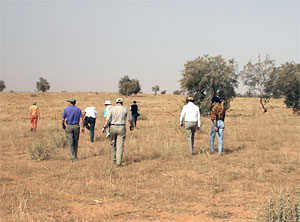Ancillary Site to Provide Key Data from Africa
Published: 31 October 2005
In January 2006, the ARM Mobile Facility (AMF) begins a year-long field campaign in Africa as part of a multi-year international experiment called the African Monsoon Multidisciplinary Analysis (AMMA). The AMF will be placed at the airport in Niamey, Niger, well within view of the Global Earth Radiation Budget (GERB) geostationary satellite. Cloud and radiative property measurements collected by the AMF will be used in conjunction with GERB data for a greater understanding of the atmosphere than could be gained from either dataset alone. While preparing for the campaign, the science team identified the need for instrumentation at an off-site location to compare radiative measurements from the natural environment of the Sahel region against those taken at the more developed surface area around the airport. To support the January start date for the field campaign, ARM engineers spent much of the 2005 summer assembling and testing the ancillary site instrument collection.

After determining what needed to be measured away from the airport, the AMF team chose to collocate with AMMA hydrologists at a site approximately 60 km from Niamey. The hydrologists had already selected that area as the most representative of the countryside, and the location was deemed suitable for making radiometric and meteorological observations. Because the remote location doesn’t have electrical power, instruments for the ancillary site were designed to run on solar/battery power. For the same reasons, a simple data collection scheme was chosen; a technician will travel to the ancillary site to manually download the data (also known as sneaker-netting). It will then be placed on the AMF site data system to supplement the data collected at the airport location. In July, the ARM Chief Engineer began assembly and testing of the procured instruments and associated equipment. Testing was successfully completed and the instruments were loaded on an airplane to Africa in September.
AMMA is an integrated, multidisciplinary project that addresses both fundamental scientific questions related to the understanding of the West African Monsoon variability, as well as practical issues related to prediction and application. Scientists involved in AMMA are studying the interactions between monsoon dynamics and scale, continental water cycle, aerosols, atmospheric chemistry, food, water and health. Niamey is one of the main sites for AMMA.
The ARM Climate Research Facility is a DOE Office of Science user facility. The ARM Facility is operated by nine DOE national laboratories, including .
Keep up with the Atmospheric Observer
Updates on ARM news, events, and opportunities delivered to your inbox
ARM User Profile
ARM welcomes users from all institutions and nations. A free ARM user account is needed to access ARM data.


















